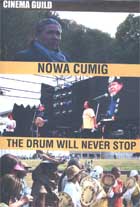
Nowa Cumig: The Drum Will Never Stop: Dennis Banks and His Movement 2012
Distributed by Cinema Guild, 115 West 30th Street, Suite 800, New York, NY 10001; 212-685-6242
Produced by Takeo Koshikawa, Masaou Yamamoto
Directed by Marie-Michèle Jasmin-Bélisle
DVD, color, 74 min.
Sr. High - General Adult
Activism, Environmentalism, Native Americans, Politics, Protest Movements, Social Movements
Date Entered: 04/08/2014
Reviewed by Wendy Highby, University of Northern ColoradoNowa Cumig: The Drum Will Never Stop: Dennis Banks and His Movement is a biographical film featuring the American Indian Movement (“AIM”) co-founder. Banks’ is a member of the Anishinaabe tribe; Nowa Cumig, his Ojibwa name, means “in the center.” And while Banks is the central personality of the piece, the primary foci of the film are the social movements that seek ecological health and justice for the earth and indigenous people. Documentary director Jasmin-Bélisle takes a non-linear path; her camera often capturing the periphery. Who participates with Banks in these social movements? Who walks, canoes, and sings with him? The film takes a circular, peripatetic approach, mirroring the tactic used by Banks and his fellow demonstrators, who organize and participate in demonstrative walks and runs across the North American continent and Japan. This is a story of heroic transcontinental journeys and cross-cultural friendships rather than a recitation of individual achievements.
Save for a four-minute preface regarding the early 1970s, this film’s chronological span is 1978 to 2011. The documentary makes use of archival footage and includes current-day interviews. Those seeking information about the 1973 Wounded Knee occupation should turn instead to David Mueller and Lynn Salt’s 2011 film, A Good Day to Die: Dennis Banks and the American Indian Movement. Nowa Cumig’s main narrative begins with the “Longest Walk” of 1978; it continues with the 30th anniversary commemoration, the second Longest Walk of 2008; and then culminates in the Longest Walk 3 of 2011. The first walk centered upon land and indigenous rights; the second walk added concerns about peace, protection of sacred sites, and environmentalism; the last walk focused upon human health and diabetes prevention. Along these trans-continental walks activists connect with local communities, gather information about the unique issues of each, and seek change. Banks has also embarked upon 13 sacred runs between the years 1978-2006. Footage from a 1988 Run for Land & Life is featured; it begins in Onondaga New York’s Six Nations Territory, then proceeds to Hiroshima and a visit with the indigenous Ainu in Hokkaido, Japan.
A substantial portion of the film concerns Bank’s cultural exchanges with Japanese friends and colleagues. As a young man in the 1950s Banks completed a military stint at a base in Japan and thus began a lifelong connection. Buddhist contemplatives Nichidatsu Fujii Guruji and June Yasuda participate in the Long Walks. Banks and his friend, the photographer Masaou Yamamoto, organize the Great Anishinaabe Canoe Race Yamamoto Cup (at Leech Lake in Minnesota). Banks, a Grammy award winning singer, collaborates on camera with Kitaro, the Japanese recording artist and composer.
Ultimately, Nowa Cumig: The Drum Will Never Stop explores the deeper meaning behind these cultural exchanges and walks. What if the drum stopped? Connections are drawn between Hiroshima, the Fukushima Daiichi nuclear disaster in March 2011, and uranium mining on Native land; archival footage of the “Hopi Prophecy” of Thomas Banyacya is included to underscore the film’s anti-nuclear energy, pro-peace stance. In the end, cultural survival is not just an issue for the Anishinaabe, the Ainu, and the Hopi; it concerns all of humanity and Mother Earth. The film concludes with Dennis Banks’ declaration that the longest walks and sacred runs must continue; we must keep going forward with love.
Jasmin-Bélisle’s film is heart-felt and hopeful. She and Banks fearlessly confront what is arguably our culture’s most pressing social problem: survival of the planet. The narration by Michael Horse provides gentle guidance along the journey. The music is marvelous; Banks sings in the film, and Pura Fé’s “Follow Your Heart’s Desire” and Floyd Red Crow Westerman’s “Custer Died for Your Sins” are noteworthy. For pedagogical purposes, the film is pertinent to Native American and environmental studies curriculum and sociological studies of social movements. In addition to the obvious subject areas of anthropology, sociology, ethnic studies, and political science, the film could apply to the arts & humanities, and it could inform policy studies regarding nuclear energy and other forms of energy and land use.